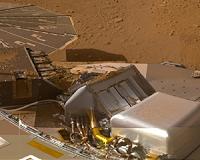 |
Tucson AZ (SPX) Oct 19, 2010 Researchers at the Planetary Science Institute have found a new explanation for how seas and lakes may have once developed on Mars. J. Alexis Palmero Rodriguez, research scientist at PSI, has been studying the Martian northern lowlands region, which contains extensive sedimentary deposits that resemble the abyssal plains of Earth's ocean floors. It is also like the floors of other basins on Mars where oceans are thought to have developed. The origin of these deposits and the formation of Martian lakes and seas are controversial. One theory is that there was a sudden release of large volumes of water and sediment from zones of apparent crustal collapse known as "chaotic terrains." However, these zones of collapse are on the whole rare on Mars, while the plains deposits are widespread and common within large basin settings, Rodriguez said. Citing evidence found in the planet's northern plains south of Gemini Scopuli in Planum Boreum, Rodriguez proposes in an article published in Icarus that groundwater emerged through extensive and widespread fractures forming the floors of ancient continental-scale basins on Mars. This led to the formation of river systems, large-scale regional erosion, sedimentary deposition and water ponding. This model does not require sudden massive groundwater discharges, he said. Instead, it advocates for groundwater discharges being widespread, long-lived and common in the northern plains of Mars. "With the loss over time of water from the subsurface aquifer, areas of the northern plains ultimately collapsed, creating the rough hilly surfaces we see today. Some plateaus may have avoided this fate and preserved sedimentary plains containing an immense record of hydrologic activity," he said. "The geologic record in the collapsed hilly regions would have been jumbled and largely lost. "This model implies that groundwater discharges within basin settings on Mars may have been frequent and led to formation of mud pools, lakes and oceans. In addition, our model indicates this could have happened at any point in the planet's history," he said. "There could have been many oceans on Mars over time." If life existed in Martian underground systems, life forms could have been brought up to the surface via the discharges of these deep-seated fluids. Organisms and their fossils may therefore be preserved within some of these sedimentary strata, Rodriguez said
Share This Article With Planet Earth
Related Links Planetary Science Institute Mars News and Information at MarsDaily.com Lunar Dreams and more
 NASA Data Shed New Light About Water And Volcanoes On Mars
NASA Data Shed New Light About Water And Volcanoes On MarsPasadena CA (SPX) Sep 10, 2010 Data from NASA's Phoenix Mars Lander suggest liquid water has interacted with the Martian surface throughout the planet's history and into modern times. The research also provides new evidence that volcanic activity has persisted on the Red Planet into geologically recent times, several million years ago. Although the lander, which arrived on Mars on May 25, 2008, is no longer operating, N ... read more |
|
| The content herein, unless otherwise known to be public domain, are Copyright 1995-2010 - SpaceDaily. AFP and UPI Wire Stories are copyright Agence France-Presse and United Press International. ESA Portal Reports are copyright European Space Agency. All NASA sourced material is public domain. Additional copyrights may apply in whole or part to other bona fide parties. Advertising does not imply endorsement,agreement or approval of any opinions, statements or information provided by SpaceDaily on any Web page published or hosted by SpaceDaily. Privacy Statement |